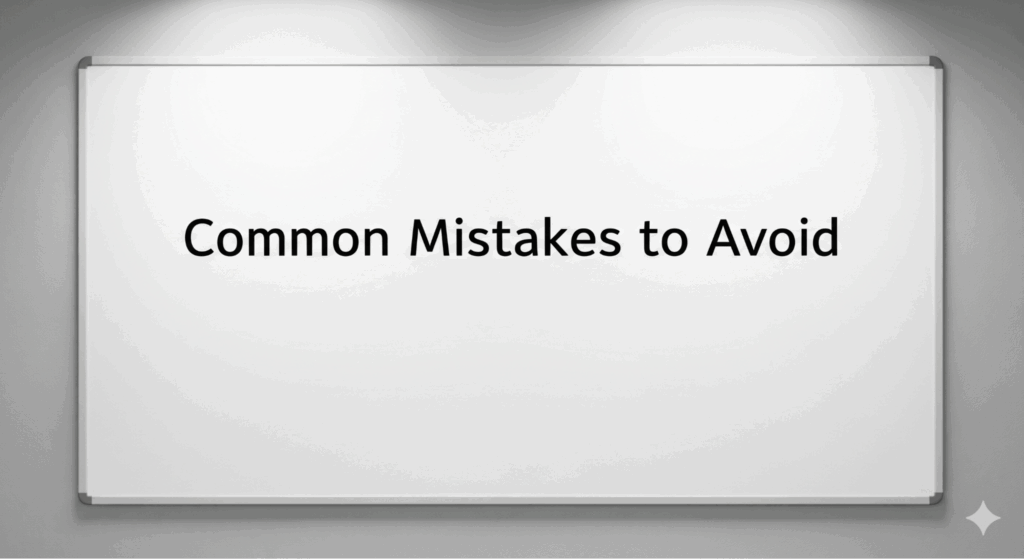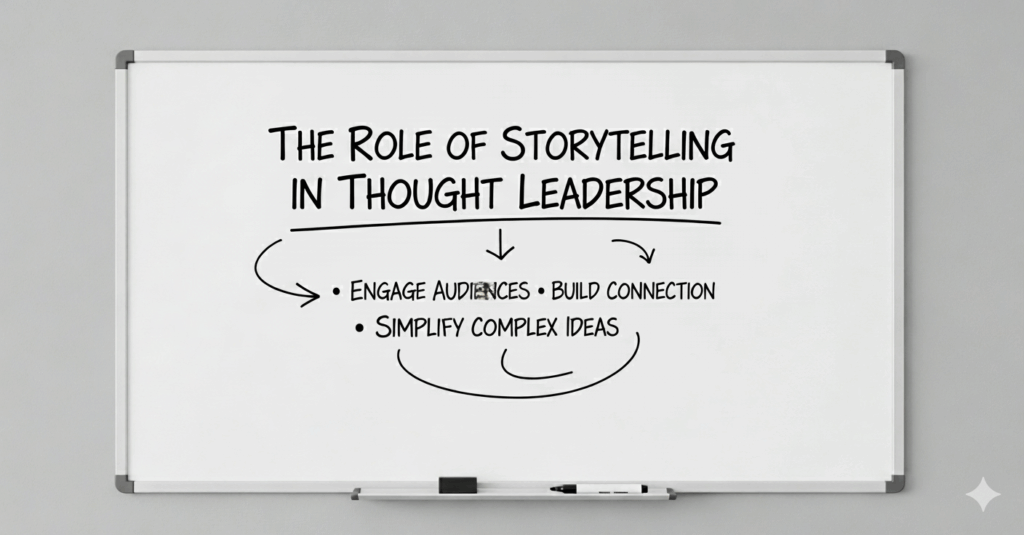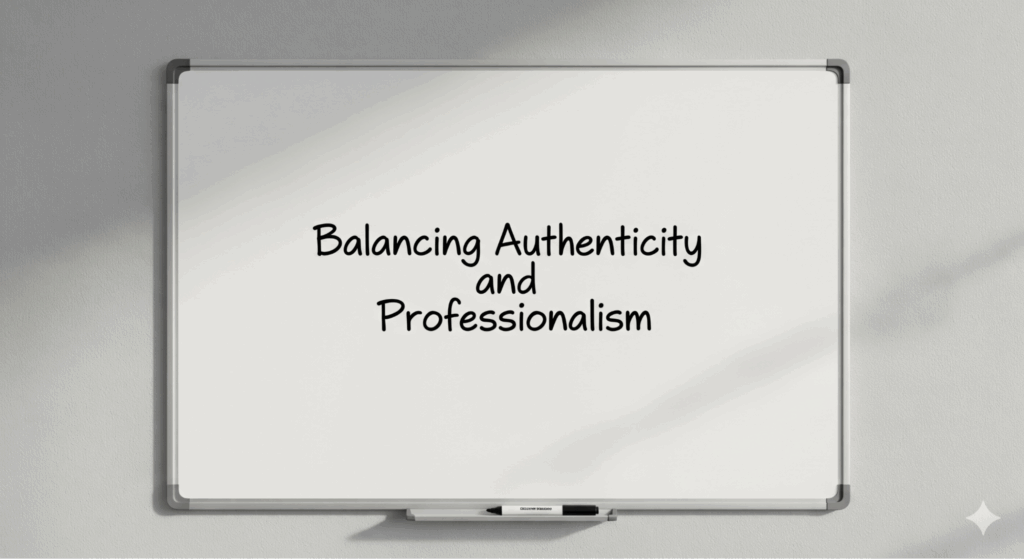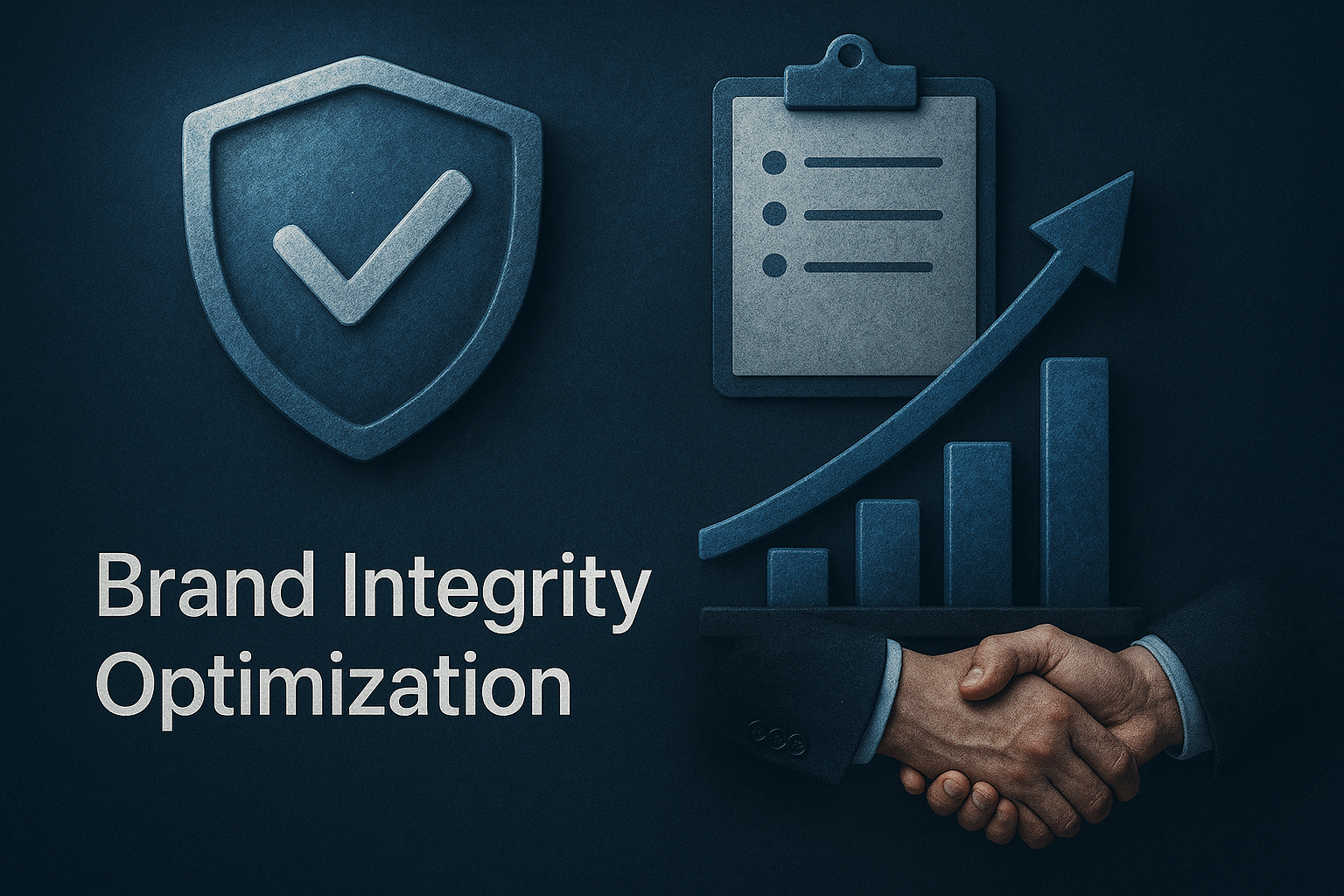Here’s why thought leadership matters for experts and decision-makers today.
It’s not about being the loudest one in the room. Thought Leadership runs deeper than that. It’s about showing you know your field and doing it in a way that earns trust. It’s about ideas that stay with people, guidance that helps, and insight that makes someone take action.
Some treat it like a badge. Others call it a strategy. The truth? It’s a bit of both. You need the knowledge, sure. But you also need the nerve to share it, the habit of showing up, and the skill to make hard things sound simple.
Look across any industry. The voices people follow aren’t just experts. They’re guides. They shape the talk, they inspire confidence, and they set direction. That’s where we’ll head next on how to build authority, stand as an expert, and create a leadership brand that lasts.
What Is Thought Leadership?

At its core, Thought Leadership isn’t about shiny titles or stacking up awards. It’s not the loudest voice in the room either. It’s the voice people trust. The one that cuts through the noise with ideas that matter.
It’s showing a new way to solve an old problem. It’s guiding others when the path ahead feels unclear. And it’s those small moments when someone repeats your words, leans on your advice, or shares your work that you see Thought Leadership come alive
It’s more than knowledge. Anyone can read a book or memorize facts. But turning knowledge into insight, insight into guidance, and guidance into influence that’s where the real skill lies. And that skill is what earns you industry authority.
Why It Matters
In a crowded market, everyone claims to be an expert. But few actually stand out. Thought leadership cuts through the noise. It tells people: “I understand this industry. I know what works. And I can help you navigate it.”
When it’s done well, it shapes expert positioning. People whether they’re clients, peers, or even competitors stop seeing you as just another name in the field. They start paying attention to what you say. Your opinion carries weight. And little by little, that influence keeps growing.
Thought Leaders vs. Influencers
It’s easy to confuse thought leaders with influencers. Influencers grab attention. They get likes, shares, and followers. Thought leaders do more. They earn respect. Their work impacts decisions, strategies, and even the future direction of an industry.
Think about it this way: an influencer entertains or persuades. A thought leader guides and inspires. Both matter, but only thought leadership builds lasting industry authority.
The Components of Thought Leadership
- Insightful Knowledge: Knowledge alone isn’t enough. People expect expertise. Thought leaders bring insights fresh, actionable, and sometimes counterintuitive. That’s how expert positioning happens naturally.
- Consistency: Showing up once isn’t enough. Thought leadership is like planting seeds. Daily, weekly, or monthly contributions build trust. Consistency signals reliability. People remember the ones who show up.
- Clarity: Complexity can scare people. Great thought leaders make things simple. They take hard concepts and turn them into clear ideas anyone can understand. Clarity strengthens authority.
- Authenticity: People sense when someone is genuine. Sharing real experiences, admitting mistakes, and staying true to your voice creates credibility. That authenticity is what transforms knowledge into influence.
Examples in Action
Take tech, finance, or healthcare. The people you notice aren’t the ones flashing big titles. They’re the ones steering the talk. They write things that get people thinking, spark debates and set the tone.
And here’s the difference: they don’t just toss opinions around. They show a way forward. Over time, people start leaning on them. They become the go-to voices others trust when the road ahead looks unclear.
The Takeaway
Thought leadership isn’t a finish line you cross. It’s more like a path you keep walking. You bring knowledge, you stay consistent, you speak clearly, and you keep it real. That’s what turns heads, builds industry authority, and makes expert positioning possible. Titles and skills alone don’t get you there.
It’s really about showing up. Sharing what matters. Pointing out a way forward when others can’t see it. And the thing is, the impact builds. One idea sticks. Another spread. Soon enough, people aren’t just hearing you out they’re actually following your lead
The Pillars of Thought Leadership

Thought leadership doesn’t stand on one idea alone. It’s built like a house, steady, layered, and supported by strong pillars. Without them, the whole structure wobbles. With them, it grows stronger over time.
Industry Authority
The first pillar is authority. Not the loud kind, but the earned kind. Industry authority comes from deep years of practice, tested knowledge, and lessons you can only learn by doing. It’s what makes people lean in when you speak.
But authority alone won’t cut it. You have to share it. Whitepapers, case studies, articles, even casual posts on LinkedIn each piece is a signal. It shows you’re not only skilled but willing to guide others. That’s how respect starts. That’s how influence spreads.
Expert Positioning
The second pillar is positioning. Everyone has expertise, but thought leadership requires clarity. What do you stand for? What’s the space you want to own? Defining that focus is what transforms you from “a professional” into “the professional” people look for.
Expert positioning means making choices. You can’t be everywhere. You don’t need to comment on every trend. Instead, you stake your ground. You share consistent insights in your niche. Over time, people stop guessing what you’re about they know.
Leadership Branding
The third pillar is branding. Not logos or slogans, but leadership branding, how you show up, how you communicate, and the trust you build with every word. It’s your reputation made visible.
Branding in thought leadership isn’t about polish. It’s about consistency. The way you write, the way you speak, the way you carry your values it all adds up. People may forget a single post, but they won’t forget a voice that feels steady, clear, and authentic.
Consistency and Authenticity
Another pillar? Showing up, again and again. Thought leaders don’t vanish after one great article or keynote. They keep sharing. They keep contributing. And most importantly, they stay real.
Authenticity matters more than clever words. When you share personal lessons, admit challenges, or break down tough concepts with honesty, people connect. They see themselves in your story. That’s where trust grows, and with it, your leadership branding becomes even stronger.
The Balance of All Pillars
None of these pillars work alone. Authority without positioning feels scattered. Positioning without branding feels hollow. Branding without authenticity feels fake. And without consistency, even the strongest message fades away.
The magic lies in balance. When industry authority, expert positioning, leadership branding, and authenticity come together, they form something bigger. They create a foundation strong enough to carry influence, inspire trust, and shape conversations across an entire industry.
Thought leadership isn’t luck. It’s built on clear pillars, step by step. Authority gives you credibility. Expert positioning makes you memorable. Leadership branding gives you a voice people recognize. And consistency keeps it all alive.
Together, these pillars turn professionals into leaders and leaders into the voices that others follow.
How to Build Thought Leadership

Thought leadership doesn’t appear overnight. It’s not a lucky break or a one-time effort. It’s built slowly, with small steps that stack up over time. The good news? Anyone willing to put in the work can build it.
Start with Content Creation
Content is the fuel. Blogs, LinkedIn posts, whitepapers, videos they all matter. But it’s not about volume. It’s about value. Share insights people can actually use. Break down complex issues into simple steps. Tell stories from your own experience.
When your content helps others think differently, they remember you. That’s the first brick in your wall of influence.
Step into the Spotlight
Words carry weight. But hearing someone speak is different. A voice in real time shows who you are, not just what you think. It adds tone, confidence, and presence that text can’t match.
And it doesn’t need to be a big stage. A small panel. A local meetup. Even a podcast with a handful of listeners. Each moment adds up. Every time you step in front of people, you give them another reason to see you as someone worth following.
Build Strong Connections
No one builds thought leadership alone. Relationships fuel growth. Partner with peers. Co-author articles. Share other leaders’ insights while adding your own take.
Collaboration doesn’t dilute your authority, it multiplies it. When others in your field recognize your voice, it strengthens your position. And over time, your network becomes your amplifier.
Leverage Media and PR
Sometimes you need a bigger stage. The media gives you that. A magazine mention. A quick quote in a news piece. Or maybe your voice on a podcast. Each one adds weight.
But chasing attention for the sake of it? That doesn’t work. The smart move is choosing the right place. The ones your audience already trusts. And here’s the thing one solid feature often beats a dozen forgettable mentions.
Show Proof of Impact
People trust what they can see. That’s why social proof matters. Awards, certifications, case studies, or client testimonials each one is evidence.
Proof says: “This isn’t just talk. Results back it up.” When combined with consistent insights, it reinforces your position as someone worth listening to.
Keep It Manageable
Here’s the catch: you can’t do everything at once. Thought leadership grows best when you pick a few strategies and do them well. Maybe you write weekly posts. Maybe you speak at one event a quarter, or maybe you focus on building media presence this year.
The point is to build momentum without burning out. Thought leadership is a long game. Balance keeps it sustainable.
The Takeaway
Building thought leadership means showing up, creating value, and earning trust step by step. Content sparks conversations. Speaking brings your voice to life. Connections expand your reach. The media adds credibility. And proof of impact seals it all together.
Measuring the Impact of Thought Leadership

Building thought leadership is one thing. Proving it works is another. Influence feels intangible at times, but there are ways to track it. When you measure impact, you know what’s connecting and what needs adjusting.
Engagement That Matters
The first sign of progress shows in engagement. Are people reading your posts, commenting, or sharing? Do they ask questions, tag others, or save your content for later? Numbers like likes or views matter less than conversations. Real engagement means your ideas are sparking thought.
Media Mentions and Visibility
Another sign of impact is when others start talking about you. Being quoted in industry articles, invited to podcasts, or mentioned by peers signals growing authority. Each feature extends your reach. Over time, visibility in respected spaces shows that your voice carries weight.
Leads and Opportunities
Thought leadership doesn’t only build reputation it attracts opportunities. Maybe it’s a client inquiry, a speaking request, or an invitation to collaborate. Leads tied to your presence are a strong indicator. They prove your insights don’t just inspire, they create action.
Growth in Your Network
Connections tell their own story. As your voice grows, more people show up. They follow, they comment, they want to be part of the exchange.
But numbers don’t mean much on their own. What matters is who’s reaching out. When it’s peers, decision-makers, or other thought leaders, that’s the sign you’re not just talking, you’re part of the bigger conversation.
Authority in Search and Reach
Search engines tell their own story. Do your articles rank higher? Does your name show up when people search for solutions in your field? Organic reach signals authority. It means people not only value your voice but also actively look for it.
Feedback and Recognition
Sometimes the best measure is the simplest one. A message in your inbox. Someone saying, that this post helped me fix this. Or, I tried your advice and it worked. That’s the real impact.
Recognition comes in other ways too. A nod from peers. An award you didn’t chase. Those moments tell you your voice isn’t just heard, it’s valued.
Refining Through Data
Metrics aren’t just numbers to celebrate. They guide your next steps. If one type of content sparks more engagement, create more of it. If speaking events lead to collaborations, invest more there. Measurement isn’t about proving success once it’s about sharpening your approach over time.
Thought leadership can’t be measured by a single metric. It’s seen in the blend of engagement, visibility, opportunities, recognition, and growth. Together, they form the picture of influence.
By tracking results and learning from them, you move beyond guesswork. You know what works, where to focus, and how to grow stronger. And in the end, that clarity keeps your voice not just heard but trusted.
Common Mistakes to Avoid

It’s easy to trip up here. Thought leadership looks simple on the surface, but there are a few traps that can quietly undo all the effort you’ve put in. Some are obvious. Others sneak up on you. Either way, spotting them early makes all the difference.
Making It All About You
The first one? Talking only about yourself. We’ve all seen it—the endless self-praise, the “look at me” posts. And sure, you might get attention for a while. But not trust. Thought leadership isn’t about selling—it’s about serving. People want ideas they can use, not just a highlight reel of your wins.
Showing Up Once, Then Vanishing
Another one? Inconsistency. You drop one brilliant article, then disappear for six months. By the time you’re back, people have already moved on. Authority doesn’t come from one big moment—it comes from steady signals. Regular posts. Ongoing talks. Consistency that makes your voice hard to ignore.
Chasing Every Shiny Thing
And here’s a big one, trying to weigh in on every trend. New buzzword, new tool, new story—you jump on all of it. The problem? It makes you sound scattered. People don’t know what to expect from you. Stick to your lane. Own your space. That’s how expert positioning actually works.
Polishing Too Much
Perfection can backfire. If every word feels rehearsed, people tune out. They want honesty. A rough edge here and there. A lesson that came from a failure, not just a win. Authenticity builds trust faster than any polished “brand statement” ever could.
Forgetting Who It’s For
The biggest slip? Forgetting your audience. It’s easy to write what you find interesting. But if it doesn’t hit their needs, it falls flat. The smartest thought leaders start by asking: what’s my audience struggling with right now? Then they answer that, simply and directly.
Most of these mistakes come from the same place thinking leadership is about you. It’s not. It’s about the people listening. When you focus on them, stay consistent, and keep it real, your voice carries. Miss those steps, and even great ideas get lost in the noise.
The Role of Storytelling in Thought Leadership

Stories are sticky. Facts can be impressive, numbers can be sharp, but stories are what people carry with them long after the conversation ends. And that’s why storytelling sits at the heart of real Thought Leadership. It takes expertise and makes it relatable. It turns abstract ideas into moments people can feel, see, and even remember years later.
Why Stories Work
Think about it when someone explains a concept with charts, it may land, but when they add a story, it lives. A founder talking about late nights at a garage desk makes innovation feel real. A leader sharing a mistake that taught them more than success ever could feel authentic. Stories cut through noise. They spark emotion. And emotions create trust.
Making Expertise Human
Expert positioning often struggles when it sounds too polished. People don’t always connect with the perfect version of leadership branding. They want something raw, something honest. Storytelling gives that bridge.
It shows not just the knowledge you have, but the path you walked to earn it. It shows the struggles behind the wins. And when done right, it makes authority less distant and more approachable.
Stories that Build Authority
Not every story is equal. Some stories inspire, others warn, and a few just show that even experts are still human. The key is choosing stories that reinforce credibility. A lesson learned from failure. A risk taken that changed direction. Or a client’s journey where insights made the difference. Each of these adds a thread that strengthens industry authority.
Storytelling Across Platforms
The best part? Stories travel well. A quick post on LinkedIn, a podcast anecdote, or a stage keynote they all work when a good story backs them. And because platforms shift constantly, a story can flex and fit. The same narrative can inspire on social media, educate in a blog, and resonate in an interview. That adaptability makes storytelling one of the strongest tools for leaders who want to stay relevant.
Blending Stories with Strategy
Of course, storytelling alone isn’t enough. It needs direction. Every story should link back to your bigger vision, your values, and your goals. Otherwise, it risks becoming just entertainment. When aligned, stories don’t just engage, they lead. They reinforce thought, build recognition, and solidify influence.
The Lasting Impact
At the end of the day, Thought Leadership isn’t just about being seen as smart. It’s about being remembered as meaningful. Facts may fade, but stories echo. They give leaders staying power. They create emotional bookmarks in the minds of audiences. And when audiences remember your story, they remember you.
Leveraging Digital Platforms for Thought Leadership

Being a leader today isn’t just about what you know. It’s about how far your voice can travel. And in this era, digital platforms carry that voice farther than any stage or printed page ever could. Thought Leadership doesn’t live in one place. It moves where people spend their time online.
The Digital Stage
Think of LinkedIn as the modern-day boardroom. It’s where professionals gather, share, and look for insights. Then there’s Twitter, or X as it’s now called, quick and sharp perfect for real-time ideas.
Podcasts? They’re the fireside chats of our time, intimate and direct. Blogs and newsletters carry depth, while video platforms like YouTube or TikTok give ideas a face and a tone. Each platform is a stage, but the audience listens differently on each one.
Playing to the Platform
The trick isn’t to shout the same thing everywhere. It’s knowing how to adapt. A long story may thrive as a blog, while a short takeaway lands better as a tweet. A case study might become a quick video. That flexibility builds reach without losing meaning. Leaders who adjust not only get heard, they get remembered.
Visibility Meets Authority
Expert positioning relies on presence. The more consistently you show up, the stronger your voice becomes. But consistency isn’t about flooding timelines, it’s about value. Sharing lessons, insights, even failures creates the kind of leadership branding people trust. Over time, this positions you not just as another voice, but as an industry authority worth listening to.
Community Over Broadcast
Digital platforms reward connection. People don’t just want polished statements; they want conversation. Responding to comments, engaging in debates, or even asking questions builds trust. It shows leaders aren’t talking at people, they’re talking with them. That sense of community makes influence last longer than a single post.
Keeping It Real
The danger of digital is slipping into noise. Endless content, recycled posts, forced branding audiences spot it quickly. The leaders who stand out are those who stay authentic. Their stories, tone, and presence remain consistent with who they are offline. And that blend of honesty with expertise is what makes digital Thought Leadership powerful.
The Takeaway
Digital platforms aren’t just tools, they’re amplifiers. They extend your reach, sharpen your influence, and give your ideas a home in the minds of audiences everywhere. Used well, they transform knowledge into impact. Because at the end of the day, Thought Leadership is less about having the stage and more about making sure your voice truly connects.
Collaboration and Co-Creation with Other Experts

No leader builds influence alone. Behind every strong voice, there are others who add depth, perspective, and reach. In Thought Leadership, collaboration isn’t a side note, it’s a powerful strategy. When experts come together, ideas grow larger than what one mind could carry on its own.
The Power of Shared Voices
Think about panels, podcasts, or even guest blogs. One expert brings clarity, another adds context, and together they create something richer. Audiences respond to this mix because it feels less like a lecture and more like a conversation. And conversations are easier to follow, easier to trust, and harder to forget.
Expanding Reach Through Co-Creation
Collaboration also opens doors to new audiences. A joint webinar introduces you to a colleague’s network. A co-authored article carries both names into new spaces. Even a short interview can spark curiosity among people who may never have found you otherwise. It’s a simple truth: shared platforms multiply influence.
Building Mutual Authority
Expert positioning doesn’t just come from what you say about yourself. It also comes from who stands beside you. Working with other leaders shows confidence, openness, and credibility. It signals you’re secure enough in your own voice to amplify someone else’s. Over time, this builds stronger leadership branding than going it alone.
Collaboration Beyond Content
It doesn’t always have to be about producing something. Sometimes collaboration is just listening, sharing space, or engaging publicly with another leader’s ideas. A thoughtful comment, a joint discussion thread, or a live Q&A can carry as much weight as a polished white paper. The format matters less than the act of showing up together.
The Trust Factor
Audiences notice partnerships. They see which experts respect each other enough to collaborate. That trust, passed between leaders, often spills over to the audience itself. It’s one of the quiet ways Thought Leadership grows influence through borrowed credibility that eventually becomes your own.
Lasting Impact of Co-Creation
At the core, collaboration reminds people that leadership isn’t about standing apart, it’s about moving forward together. By co-creating, you show that ideas grow stronger when shared. You demonstrate that authority isn’t diminished when voices join; it’s expanded. And in a world overflowing with solo voices, the ones that blend often stand out most.
Balancing Authenticity and Professionalism

It’s a tightrope. Show too much of yourself and it feels unguarded. Hide behind polish and you lose the spark. Thought Leadership lives somewhere in between. Not stiff. Not messy. Just real enough to connect, and sharp enough to be trusted.
Why Authenticity Pulls People In
People lean toward what feels human. A small story. A slip that taught a lesson. Even a quick note about the struggle behind the success. That’s what sticks. Because nobody wants to wear a mask. They want the person behind it.
Think of a leader who talks only in statistics. Impressive, sure. But hard to relate to. Now picture another who shares how they almost quit, how doubt crept in, how a failure shaped their next step. That story lands differently. It feels real. It builds a bridge.
Why Professionalism Still Counts
But honesty alone isn’t enough. Without structure, without care, words can lose weight. Professionalism gives the message backbone. It shapes raw thoughts into something clear, something steady. And that balance keeps respect in the room, even when you’re being vulnerable.
Professionalism doesn’t mean hiding behind jargon. It doesn’t mean stripping out warmth, it simply means showing up prepared. It means your ideas have shape, your message has order, and your audience feels like you’ve respected their time.
Where the Line Gets Blurry
The danger is leaning too far. Share every detail and it feels careless. Stay too polished and it feels cold. And once cold sets in, connection fades. The leaders who stand out are the ones who mix the two. They let warmth show without letting authority slip.
This line isn’t fixed. For some, it means sharing stories freely but cutting out what feels too personal. For others, it’s allowing a little humor in a boardroom or adding a touch of humility in a keynote. Each leader finds their own balance. The key is knowing that balance matters.
Small Ways to Do It
Start with your stories. Tell them, but don’t wander. Make sure the takeaway shines brighter than the detail. Use a conversational voice, but don’t lose clarity. Show your personality, but never let it drown out your point.
Think of it as layering. Authenticity lays the base, it grabs attention and builds trust. Professionalism sits on top, it organizes, clarifies, and strengthens. Together, they work better than either one alone.
The Lasting Effect
When authenticity and professionalism meet, trust builds. And trust is what makes people follow. Not just for one article or one speech. But over time.
Audiences don’t only remember the charts or the research. They remember the leader who spoke like a human. The one who owned both strength and flaws. The one who made them feel both safe and inspired.
That’s the lasting power of balance. Thought Leadership that feels real enough to touch, and steady enough to lean on. People don’t just hear it. They believe it. And more importantly, they remember it.
The Connection Between Thought Leadership and Trust

Influence doesn’t stick without trust. You can talk, write, post every single day. But if people don’t believe the voice behind it, the message fades fast.
At the heart of Thought Leadership, there’s only one real base of trust. Without it, even the sharpest ideas end up carrying little weight.
Why Trust Matters
Trust is the invisible thread that ties leaders to their audience. It makes people lean in, listen, and return for more. Without it, ideas sound like noise. With it, even a single phrase can shape direction. People don’t just remember what you say, they remember how you made them feel.
Think of industries where skepticism runs high. Finance, health, technology. In these spaces, facts matter, but belief matters more. A trusted leader can move conversations forward, while a leader without trust can get ignored, no matter how smart the message is.
Building Credibility Step by Step
Trust doesn’t appear overnight. It builds slowly, through consistent actions and honest words. Each post, each talk, each interaction adds a brick to the wall. Authenticity plays its role showing people the person behind the knowledge. Professionalism keeps it steady delivering clear, reliable insights. Over time, these moments stack up, and credibility takes shape.
Transparency as a Trust Signal
Audiences today expect openness. They can sense when something feels forced or hidden. Leaders who admit uncertainty or acknowledge challenges often gain more respect than those who pretend to have all the answers. That transparency doesn’t weaken authority. It strengthens it. It shows confidence in being real.
Consistency Creates Belief
Trust isn’t built by one great article or speech. It comes from showing up, again and again, with value. Sharing insights that matter. Following through on promises. Keeping the voice steady across platforms and moments. That rhythm tells people you’re reliable. And reliability is a cornerstone of trust.
The Payoff of Trust
When trust is in place, Thought Leadership does more than inform. It inspires. It shapes opinions and it creates loyalty. People share your words, not because they were clever, but because they believed them. They invite you into bigger conversations. They see you not just as a source of knowledge, but as someone worth following.
Lasting Impact
In the end, trust is what turns leaders into landmarks. Others may shout louder or post more often, but trusted voices stand firm. They become the reference point. The place people return to when the noise gets too much. That’s the power of pairing Thought Leadership with trust it creates influence that doesn’t fade with the scroll.
Future Trends in Thought Leadership

The way people build authority is shifting. Fast. What worked five years ago doesn’t hit the same day today. And what feels fresh now may be old news tomorrow. So, let’s look at where thought leadership is heading and what that means if you want to stay ahead.
Shorter, Sharper Content
Attention is shrinking. People don’t want walls of text. They want quick insights. A story they can grab in under a minute. Future thought leaders won’t always publish 3,000-word essays. They’ll share bite-sized pieces that still carry weight. Short. Clear. Useful.
Trust Over Titles
Authority used to come from the name on your business card. Not anymore. Audiences care less about job titles and more about lived experience. Real stories. Real results. The trend is clear, trust is earned, not assumed. And it’s earned by showing up with honesty, not just credentials.
The Rise of Video Voices
Video is taking over. Not just polished productions but raw, straight-to-camera clips. No script. No heavy editing. Just a person with an idea, sharing it fast. That’s how people connect. Thought leadership will keep moving in this direction where your tone and presence matter as much as your words.
AI as a Partner, Not a Threat
AI isn’t replacing thought leaders, it’s pushing them to be sharper. The future isn’t about who can generate content. It’s about who can add perspective on top of it. Machines can give you data. Only people can give meaning. The leaders who win will be the ones who combine both.
Communities Over Crowds
It’s no longer about speaking to everyone. The next wave of thought leadership is niche. Smaller groups. Tighter circles. Leaders who build real communities around a shared idea will carry more influence than those shouting to the masses. Depth will beat reach.
Looking Ahead
The future of thought leadership won’t be about noise. It will be about clarity. About showing up often, speaking simply, and staying real. The tools will change. Platforms will shift. But the core stays the same, people follow voices they can trust. And trust is what carries forward, no matter the trend.
Conclusion
Thought Leadership isn’t about using clever words or flooding people with posts. It’s about leaving something real behind. A thought that sticks. A story that makes someone pause and trust what you say.
Those little things add up over time. Sharing an idea that feels honest. Owning up when you get it wrong. Holding on to your values, even when it costs you. That’s the stuff that stays with people.
Anyone can talk. Not everyone connects. The ones who stand out find the balance professional, yes, but still human. They don’t push for trust. They let it grow.
In the end, it’s never about a title. Titles fade. What matters is showing up, over and over, with something people can use.. They’ll carry weight. And that weight is what builds respect. One step at a time.




